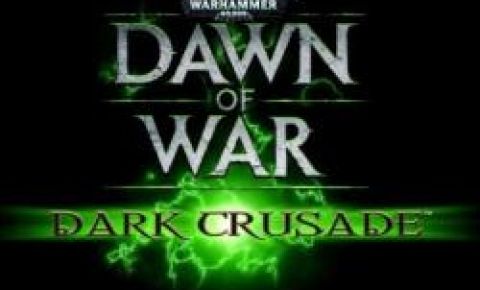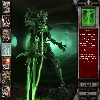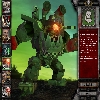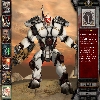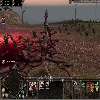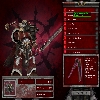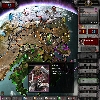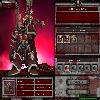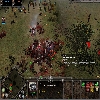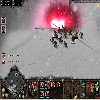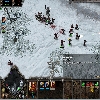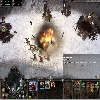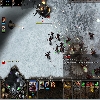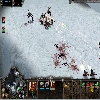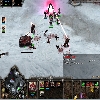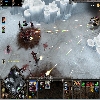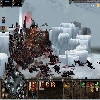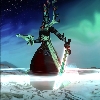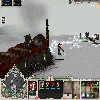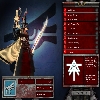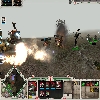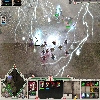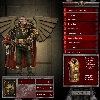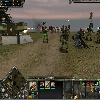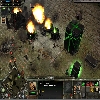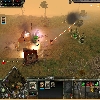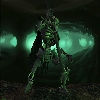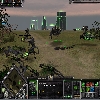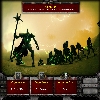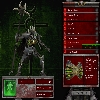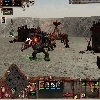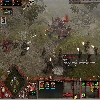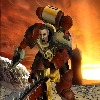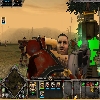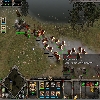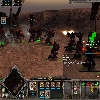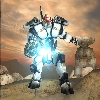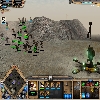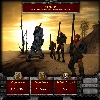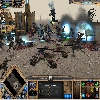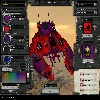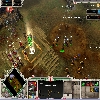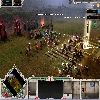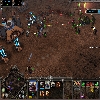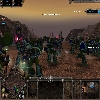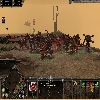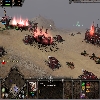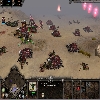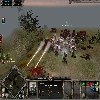The 41st millennium finds the remote planet Kronus as battlefield for a new crusade. Seven races fight for supremacy. The war can only conclude with the total victory of one race and the complete destruction of all the others. Space Marines rise up against their former allies, the Imperial Guards; the traitorous former legions of the Emperor, defeated ten thousand years before, come back as armies of Chaos to take their shot at ruling the deserted planet; the destructive Orks join the war; the enigmatic Eldar army, through magic and trickery, trying to outmatch all others; the young, yet frighteningly efficient race of the Tau Empire wants to control the universe for "The Greater Good"; against all living creatures rise the Necrons, that have been lying dormant for 60 million years.
The first expansion pack to Dawn of War, Winter Assault, featured one new race and two single player campaigns. Now the second expansion, Dark Crusade brings forward two completely new races: Tau Empire and Necrons (the rest of five races being known from the previous games of the series) and a brand new single player campaign set in the deserted lands of Kronus. The Tau Empire is a young race driven by its ideology. They've conquered and integrated many other races providing themselves with an incredibly flexible force that can match the strength of any military in the galaxy. On the other hand, the Necrons were among the first creatures to come into existence. They once swore to rule the living world and now they rise from their crypts to harvest all life there is. Having the bonus of an unmatched technology and no fear whatsoever, battling them is like fighting Death itself.
Story Only the set is the same, as the story is different for each of the seven races. Every one of them has good reasons to fight for the conquest of the planet and the extinction of all enemy races. Each race settled its own stronghold in the mysterious lands of Kronus, not even suspecting what this war will bring.
After inspecting the planet in the name of the Emperor, the Space Marines conclude there are dark secrets and holy relics here that need their protection, thus they can not live yet. Along came the Imperial Guards to claim the planet in the name of the Emperor and add it to the million other planets of the Imperium, determined to destroy all factions that may oppose to this, including their brothers-in-arm if needed. The most brutal and sadistic race in the known universe could not miss on such a carnage opportunity, so the bloodthirsty Orks took their place on the battlefield. Driven by the whispers about immortality and unlimited powers of their gods, the Chaos armies sprung to the field in yet another attempt to extinguish mankind.
The present war also caught the attention of the Tau Empire, highly devoted to their quest to unite the universe under a common cause (their own obviously). High - tech battlesuits stand ready to reclaim the planet and drive back the invaders. This young race of robotic nature outmatches its enemies in terms of fire range and power, presenting itself as a redoubtable adversary.
Faithful to the god of war, Khaine, the nomads of the space are waiting for their time of glory when their enemies would be destroyed one by one. As the remnants of an ancient and (long time ago) most powerful race, the Eldars, are the only ones that know of the dark past of the planet and the horrors that this place once celebrated. They fight in fact to save the galaxy, but due to their egocentric nature they are willing to sacrifice the entire human race in the process.
The underground of the desert hides a terrifying secret of which only the Eldars are aware of - the existence of another ancient race. But this race could bring the extinction of all life in the universe if allowed. The Necrons, once rulers of the planet, extended vast tunnels and funeral chambers all over to house the bones of the fallen races that succumbed to their purge and eventually make this planet their retirement place. The excavations conducted on the surface awoke the deathless race and allowed them to notice the thriven galaxy ready to be harvested of all life forms. With their unique technology achievements they might just be able to do that if no other highly powerful race opposes (like the Eldars that want nothing more than to eradicate them - although the metal of their skeletal frames regenerates itself, making the Necrons practically indestructible).
The planet holds yet more mysterious secrets and each race is bound to follow its own path and uncover them gradually. From additional bonus side commanders to technological improvements, Kronus has plenty to offer for every one of its seven pretenders. But nothing is for free and they have to battle one another for the 25 provinces. With each new conquered province they get a little closer to past stories and slowly unravel their own stories. The single player campaign actually presents the history of the war seen through the eyes of the seven races, while still presenting the individual stories of the world's provinces.
Concept Further expanding the gaming experience from Warhammer 40.000: Dawn of War, Dark Crusade brings into the light the conflict of interests between ancient races, destructive forces and protectors. They all fight for something: greed, pride, greater good, mere destruction or extending the borders. All of them engage in this life - or - death war hoping to become the ultimate ruler of the planet.
Except for the additional races and the distinctive story planet Kronus has to uncover, the rules of the game are just the same as in Dawn of War and the first expansion, Winter Assault. The same awesome game engine previously used (of which an imbued version is also present in the recently Relic release, Company of Heroes) does a very good job at introducing the atmosphere of the 3D fantasy RTS.
Having at your disposal a vast piece of land, divided into 25 provinces, you are to get in control of one of the leaders in this war and lead his/her (although I'm not sure about the Tau commander Shas'o Kais, I have no doubts about the Eldar Farseer Taldeer of Ulthwe - that is definitely a woman) race to victory.
Although you may need to apply some tactics on the adventure map too, the strategic skills are best put to work (as expected) on the combat maps. Following the "tradition" of the series, the resource gathering and micromanagement is kept as easy as possible, allowing the player to concentrate on war tactics. The player still needs only to take control of certain strategic points and defend ancient relics or annihilate all opponents by destroying their HQs. Your money (resource) spending abilities are only used when it comes to managing your units. There are several weaponry upgrades that are available once you properly research them and you can also increase the basic number of troops in a squad to a maximum set level. That's it! Check the status of your troops once in a while and you'll do just fine.
Battles are all about the best combat formation - melee infantry supported by lots of range units is usually one of the best strategies. Being a squad orientated strategy it is only obvious that the team may support an additional unit that plays the role of squad leader. Each race has distinctive commander's (when I say "commander" I mean leaders, heroes as they all have different job names in direct correlation to the race they are part of) abilities and despite the similarities between some races' building trees (the already known races), the units are rather different so don't be scared to try every one of them. The newly added ones - Tau and Necrons - are however slightly different.
The most impressive tech tree belongs to the Necrons (I don't know why, but they always seem to have the advantage of the most ingenious technologies and units no matter what game you're playing). All undead units get through to the surface of the planet using the Necron Monolith (HQ). The rest of their buildings have the sole purpose of allowing more powerful units to be produced and conduct the needed researches. Another interesting aspect when it comes to the deathless is that the only units that can take control of the strategic points are the small building bugs, in total opposition to all other races where the building units are usually the only ones that cannot seize control of strategic points.
It wouldn't be much fun if you couldn't customize your leader's abilities, that's why once you successfully make a certain number of conquests or achieve certain objectives, you can select a special wargear that can boost his powers (increased health, ranged and/or melee damage, reveal special abilities, increase the morale of its own army). Another bonus gained from liberating some provinces is that the commander can get very helpful, powerful sidekicks (these will cost too; the advantage is in purchasing them on the adventure map and having a small powerful squad from the first seconds on the battlefield).
Speaking of customization, be sure to check out the Army Painter option of the game which allows full personalization of units' colors. This option is also accessible from the multiplayer and skirmish games. If you want "something different", but don't know what, just browse through the random colorist the computer generates until you find a satisfying one.
Gameplay The only reasonable thing to say about this expansion is that it offers a uniquely thrilling gaming experience. Two years after the release of the original Warhammer 40.000: Dawn of War, the universe shaped by the series is kept alive and even feels fresh with this new expansion pack. The bonus is that the single player campaign does not require the original DoW; that is only needed in the multiplayer games for playing one of the old races (you don't need it to play against an old race however).
There is not much to say about the action on the adventure map. This is the place to choose your next step in conquering the entire planet and thus be able to find a piece of the puzzled story the planet hides. The experience here resembles a TBS game as you have one move per turn (two if you control a specific province) and than you have to let your enemies make their move. Your commander can only move to adjacent provinces (unless you get a hold of the starport and you are able to drop the leading squad in any province that doesn't house a stronghold). Each of the small pieces of land is attached a number that specifies an approximate defense rating so expect a tough battle once it approaches or gets past 10. There are also various bonuses to be gained from the provinces. You can opt for an automatic fight, but that usually means you've given up hope to actually win the battle. Stronghold provinces are the hardest to conquer (evidently), but this is equivalent to annihilating one of the enemy races.
The adventure map is also the place to resurrect fallen sidekicks your commander might have gained on previous conquests. It's also the place from where you can hire troops to protect the designated province (that will only give you a head start in the beginning of the battle). When you're finished acquiring troops get on the battlefield for a battle of massive proportions.
Players are placed on the edges of the map. Usually the base is somewhat protected by high level terrain with no more than two-three accessing paths. As I already said before, the building tree is not very widely spread. There are 11 buildings to choose from. Following on the footsteps of its predecessors the game also permits the player to evolve even without making excessive use of materials in an attempt to speed up production of a certain unit. This is also constrained by the population cap, increasable only by conquest of new strategic points. Although it varies depending on the race, the maximum possible population is 200 (don't forget that squads rarely take only one spot).
The path to enemy bases benefit sometimes of the addition of preexisting concealment lairs offering cover in case of a fire exchange. You could just wait there for the enemy to advance to your base, but than again, why wait? You'll have to destroy their HQ anyways, so better make haste for it, not permitting them to regain their strength. There isn't much to hinder in any way the gameplay. The pathfinding works well (it's nothing brilliant, but it does the job). The computer puts up a fair fight (according to the 3 levels of difficulty - easy, normal and hard). And most importantly, the armies of the seven races are pretty balanced in terms of unit abilities. Although health/life is a most important attribute, your units' combat skills are affected here by morale too (there are certain units trained to increase/decrease it and it is also altered by the actual fighting - increases if the squad inflicts damage and decreases if it takes damage). To make a long story short, Dark Crusade offers an excellent gaming experience.
Video RTS fans everywhere are probably already familiar with the game engine and know exactly how high is the level of details that the battlefield has to offer. True, it's still no match for the realistic graphics of Company of Heroes, but than again that was a WWII inspired game and this is a fantasy continuing a long time legacy that started with a tabletop game. Let me just mention the great zooming level and the free camera moving that allows you to see the visceral battles from the front lines.
We're already used to good unit design in the games Relic produces, and Dark Crusade is no exception. Soldiers will run pleasantly on the maps and will even use some imaginative attacks. Don't panic if you see big mean machinery grabbing one of your troops in their hook-like arms, breaking its bones than throwing it far away. The game features plenty of corpse and blood scenes, appealing to even the most demanding players.
The combat maps offer a few types of terrain, ranging from green hills to desert dunes, volcanic terrain and snow covered heights. Without making use of excessive scenery details (watersides, trees), the maps are nicely designed, keeping the overall war atmosphere present. Fade traces of old monumental sites are scattered throughout the lands and ancient relics have such an importance that they are worth the fate of a battle (defend all of them well and in 5 minutes victory is yours).
Sound "Do you know what you ask?" "Walk softly and carry a big gun." "Shall I divine your next move?" This is the kind of remarks that you may expect from your troops and these are just an extremely small part of all your units can amuse you with. Their voices are nicely heard accompanied by inspiring combat music in the background. It seems like a lot of work has gone into sound, which is a very good addition to the outstanding gaming experience.
Multiplayer The best thing about RTS games is normally the multiplayer option. Well, when it comes to Dawn of War we really cannot complain of either badly implemented AI or frivolous campaign storyline. Yet the multiplayer makes a good figure too. Of course you are allowed to play any of the seven races (let's do a short memory test: Space Marines, Imperial Guards, Orks, Chaos, Eldar, Tau Empire and Necrons). Do keep in mind that you will only be able to play Tau and Necrons using the expansion alone. If you feel like taking it easy you can pick a few allies or try to defeat them all by yourself (I did tell you that the armies are rather balanced so there is no major advantage to either race, right?).
As any respectable game that tries to offer the best to its fans (and future fans once the story gets you), Dark Crusade comes with a long list of maps to be used in multiplayer and skirmish games and the necessary tools to create your own. The number of players ranges from 2 to a maximum of 8 players. There are several ways to win the war in multiplayer games - annihilate all enemies, take hold of and defend all the relics on the map or be in control of more than a specified percentage of strategic points. The last two options are based upon conquering and then protecting specific regions of the map for a number of minutes (the game displays on the top right side the remaining time until victory).
Depending on the selected map there are various tactics to be applied in battle, from defensive strategies when you surround your entire base with turrets/cannons ("big gunz" as orks say, but remember you can only build 6 turrets per HQ) to first minutes rushes of low level infantry units that you upgrade on the way to the enemy base. You can even take your enemies by surprise if your race can develop the stealth ability. So you see, there's quite a wide choice of tactics at your disposal. You can even try to climb the official site's ladder if you think your friends are not much of a challenge anymore.
Conclusion It's hard to get a short conclusion out of a very good game (even harder to write a short description of it as I managed to prove myself). There are games where you can't stop complaining about bugs, poor story or bad AI implementation - definitely not the case here. There are modest games that do not rise to the expectations - again doesn't fit. And there are games for which you can only have words of praise - yeap, this is it. I think I've already used a big amount of them and we wouldn't want Relic Entertainment to think there is nothing better to be done. Don't get me wrong. The game isn't perfect, you may come across something that can be improved, but it offers a wide variety of tactical possibilities and every feature is conscientiously implemented. There isn't anything in the game that just doesn't work or doesn't fit into the series epic.
Maybe a little more work could go into the creation of more animated map scenery or even more complex maps, special squad experience points or something, but the fact is that Dark Crusade has all the decisive arguments to be a top game. It brings the fresh flow the Dawn of War fans were waiting for and at the same time it conquers new hearts (mouse using fingers especially) by offering an exciting stand alone experience that needs no other knowledge of past events in the history of the game series. All in all, my hat is off in front of the people at Relic: keep it going guys!
 14 DAY TRIAL //
14 DAY TRIAL // 